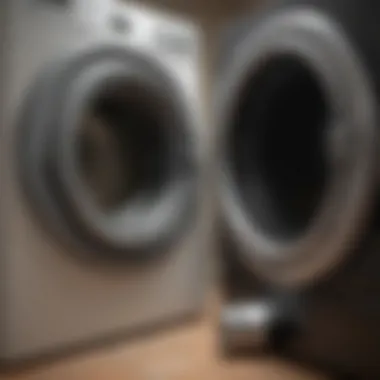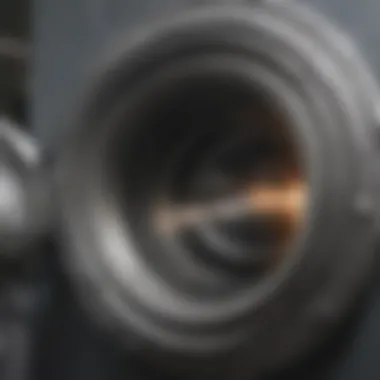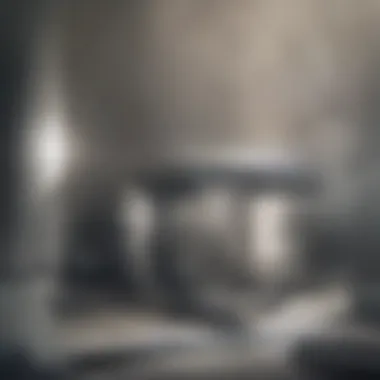Essential Guide to Dryer Vent Pipe Cleaning


Intro
Cleaning your dryer vent pipe is an essential yet often overlooked maintenance task. Many homeowners do not realize just how critical it is to keep this area clear of lint and debris. Over time, a neglected dryer vent can lead to serious consequences, including reduced efficiency of the dryer, increased drying time, and, alarmingly, fire hazards. Understanding these factors highlights the necessity of regular cleaning.
In this guide, we will provide a comprehensive look at the techniques and tools needed for dryer vent maintenance. We’ll also discuss the potential dangers of skipping this crucial upkeep and offer step-by-step instructions for effective cleaning. For those who prefer to hire professionals, we will outline what to look for when choosing a service.
By engaging with this guide, you will gain insights not only into the cleaning process but also into best practices for maintaining your dryer’s efficiency and safety.
Let’s delve into the topic and ensure your home stays both safe and efficient.
The Importance of Cleaning Your Dryer Vent
Cleaning the dryer vent is crucial for several reasons that contribute to both safety and efficiency. Neglecting this task can lead to serious issues that affect not just the appliance but also the surrounding environment within a home. Understanding the significance of maintaining cleanliness in the dryer vent helps homeowners prevent potential hazards and sustain longevity in their machines.
Understanding Dryer Vent Functionality
A dryer vent serves as the exhaust pathway for hot air and moisture produced during the drying cycle. It effectively channels these elements outside, preventing excessive heat and humidity from accumulating within the dryer itself and the home. A properly functioning dryer vent ensures that the appliance operates optimally, minimizing the risk of overheating and potential fires. Thus, a clean vent contributes to the desired performance of the dryer.
Consequences of Neglect
Failing to clean the dryer vent can result in several adverse effects, the most concerning of which are:
Fire Hazards
Clogged dryer vents can trap lint, a highly flammable substance. The buildup may ignite due to the heat produced during the drying process, leading to significant fire hazards. Statistics show that home fires attributed to dryers cause substantial property damage and even loss of life. Regularly cleaning dryer vents helps eliminate lint accumulation, mitigating the risk of such devastating events.
Reduced Efficiency
A dryer that struggles to expel air may require multiple drying cycles to effectively dry clothes. This indicates reduced efficiency and can lead to wear and tear on the machine. When the dryer is not functioning correctly, it may also overheat, leading to further mechanical issues. Regular cleaning ensures that the dryer vent remains unobstructed, allowing the appliance to work as intended.
Increased Energy Costs
As efficiency decreases, energy consumption often increases. A clogged dryer vent can lead to significantly higher electricity bills as the dryer works harder to dry clothes. In many cases, homeowners may not initially recognize that their energy spikes are tied to an obstructed vent. Maintaining cleanliness in the vent helps to keep operating costs manageable and can provide savings in the long term.
Overall, a clean dryer vent enhances safety, efficiency, and cost-effectiveness, making maintenance an essential part of operating a dryer.
Signs That Your Dryer Vent Needs Cleaning
Understanding the signs that indicate your dryer vent needs cleaning is crucial for maintaining both safety and efficiency. Ignoring these signals can lead to serious consequences not only for the appliance itself but also for your home. Recognizing early warning signs can prevent potentially hazardous situations. The following are three primary indicators that your dryer vent may require immediate attention.
Longer Drying Times
One of the first signs that your dryer vent needs cleaning is longer drying times for your clothes. If you notice that items are taking considerably longer to dry than usual, there could be a blockage in the venting system. Lint buildup restricts airflow, causing the dryer to operate less effectively. This not only extends drying cycles but also indicates that the appliance is working harder than it should.
Check the vent exit outside your home. If there is little to no air coming out while the dryer is running, it might confirm a blockage. Addressing this issue promptly can help restore normal drying times and enhance the overall efficiency of your dryer.
Overheating Dryer
An overheating dryer is another serious sign that the vent needs to be cleaned. If the surface of the dryer feels excessively hot to the touch, it may suggest that the heat isn’t being effectively vented outside. This can happen due to lint accumulation, restricting airflow and causing excess heat buildup. Overheating can not only damage the dryer’s components, but it may also increase fire risks.
Consequently, if your dryer seems unusually hot after a cycle, it is vital to investigate the venting system. Regular inspection can prevent overheating and help in maintaining a safe drying environment.
Unpleasant Odors


Finally, if you detect strange or musty odors coming from your dryer, it signifies that something is amiss. Odors often arise from trapped lint and moisture in the venting system. This creates a perfect environment for mold and mildew to develop. These organisms can cause unpleasant smells and may be harmful to health if left unchecked.
To combat unpleasant odors, check the vent and cleaning it as soon as possible. Eliminating lint and debris not only addresses the odor issue but also keeps your dryer performing optimally. As you consider these signs, remember that regular maintenance is key to avoiding more significant problems down the line.
Keeping an eye out for these signs can save you both time and potential hazards. Regularly cleaning your dryer vent should be a part of your home maintenance routine.
Necessary Tools for Cleaning a Dryer Vent
Cleaning your dryer vent is a critical task for maintaining appliance efficiency and safety. The right tools can make this process simpler and more effective. Without proper tools, cleaning can become daunting. Budgeting for necessary equipment is an essential part of ensuring a successful cleaning operation.
Basic Cleaning Supplies
Vacuum Cleaner
A vacuum cleaner is fundamental in the cleaning of a dryer vent. It helps to eliminate lint and debris that accumulate in the vent system. A vacuum with a long hose is ideal, enabling easier access to hard-to-reach areas.
A key feature of a vacuum cleaner for this task is its suction power. Strong suction is beneficial in removing stubborn clogs. However, some vacuums are too bulky for tight spaces, making them less effective. A specialized vacuum attachment for lint removal can also enhance efficiency.
Brush Kit
Using a brush kit designed for dryer vent cleaning is vital. These brushes are specifically made to dislodge lint buildup. Most kits come with different sizes, ensuring that all vent diameters can be accommodated. This allows for better cleaning outcomes compared to non-specialized brushes.
A prominent aspect of a brush kit is the bristles' stiffness. Stiffer bristles are effective for scrubbing away tough residue. However, care must be taken to avoid damaging delicate vent materials. A well-chosen brush kit can be a practical investment for regular vent cleanings.
Flexible Rods
Flexible rods are an essential addition for those looking to clean their dryer vent thoroughly. These rods can extend to reach deeper into the venting system. This flexibility allows for better maneuvering around bends and offsets in the ductwork.
The unique feature of flexible rods is their modularity. They can be connected to customize the length based on your vent size. This makes them particularly useful in complex installations. However, using them requires a degree of care, as excessive bending may lead to breakage.
Safety Gear
Gloves
When cleaning a dryer vent, gloves are a necessary safeguard. They protect your hands from sharp edges and irritants. A well-fitted pair of gloves can enhance grip on tools as well.
The most vital characteristic of gloves for this task is their durability. For instance, rubber or heavy-duty latex gloves are often recommended. These types are resistant to wear and tear but may limit dexterity for some individuals. Choosing the right gloves ensures both safety and efficiency during the cleaning process.
Safety Goggles
Safety goggles not only protect your eyes from dust and debris but also from any potential liquid cleaners. They offer a barrier against particles that may become airborne. Good visibility during cleaning is crucial, making goggles a smart choice.
A primary benefit of safety goggles is their ability to fit securely around the face. This prevents dirt from entering. However, bear in mind that some goggles can fog up, which can create visibility issues. Selecting anti-fog goggles can solve this common problem.
Respirator Mask
A respirator mask is advisable when cleaning a dryer vent, particularly to avoid inhaling dust and lint particles. Proper respiratory protection is essential if you have allergies or respiratory conditions.
The notable aspect of a respirator is its filtration capability. A mask that filters out small particles offers a high level of protection during the cleaning process. However, wearing a mask can feel uncomfortable after prolonged use. Finding one that balances comfort and filtering efficiency is crucial for user satisfaction.
Step-by-Step Guide to Cleaning Your Dryer Vent
Cleaning your dryer vent is crucial. It ensures your dryer functions efficiently and safely. By following a systematic approach, you can effectively remove lint and debris that accumulate over time. The Step-by-Step Guide provides clarity and structure, helping avoid mistakes that could compromise safety or effectiveness.


Preparation Before Cleaning
Preparation is essential before diving into the cleaning process. Two main steps must be taken to ensure a safe and thorough job.
Unplugging the Dryer
Unplugging the dryer is an important first step. This action removes electrical power, thus preventing accidental starts while you clean. Safety is paramount. The key characteristic of unplugging the dryer is that it directly protects you from electrical hazards. A malfunctioning dryer could lead to shocks if power remains connected during maintenance. While it may seem like a small task, it is invaluable and a basic practice in appliance care.
When you unplug your dryer, you'll also be able to focus entirely on cleaning without any distractions. This action can also prevent possible damage to the dryer’s internal components during cleaning, ensuring longevity. In summary, unplugging the dryer is essential for both personal safety and equipment protection.
Accessing the Vent System
Accessing the vent system is the next critical step. This involves locating and reaching the dryer vent. The primary benefit is that it allows for a comprehensive cleanup, targeting hidden areas where lint may build up. The unique feature of accessing the vent system involves ensuring you can reach all sections of the vent pipe, which is vital to effective cleaning.
It may require moving the dryer away from the wall or removing any obstacles in the way. This process can also be cumbersome, as it might involve some physical effort. However, doing it properly ensures you can clean the entire vent system efficiently. Troubles with accessibility can lead to incomplete cleaning and even potential hazards, diminishing the safety and efficiency of your dryer. Thus, accessing the vent system is fundamental for thorough maintenance.
Removing the Vent Cover
Removing the vent cover is the next logical step. It generally involves unscrewing or unfastening the cover. This allows access to the interior of the vent. By taking this cover off, you ensure the removal process can begin without any impediments. It is essential to handle the cover carefully, as it may contain accumulated lint that could disperse into the air when disturbed.
Cleaning with a Vacuum
Using a vacuum is one of the most effective methods for cleaning a dryer vent. A vacuum cleaner with a long attachment can reach deep within the duct. This method is efficient as it collects lint without redistributing it into your home. Make sure to use a high-quality vacuum with strong suction power.
Regular cleaning with a vacuum can also extend the life of your dryer. By consistently removing lint buildups, you might prevent future blockages that can lead to overheating or, worse, fires.
Scrubbing the Interior
Scrubbing the interior is another crucial step in the cleaning process. This part involves using a brush kit to dislodge stubborn lint that may not come loose with just a vacuum. A good brush kit can get to those tight corners that a vacuum might miss.
Be thorough during this step as missed areas can lead to future accumulation and decreased dryer efficiency. Depending on your usage, a scrub might be necessary every few months for optimal results.
Reassembling and Testing
Reassembling and testing is the final step in the cleaning process. After cleaning the interior of the vent, you need to reattach the vent cover securely. Once everything is put back together, plug your dryer back in and run it for a few minutes. This checks that the airflow is normal, and there are no obstructions.
Effective reassembly guarantees that you have not left any sections misaligned or improperly attached. Proper closure also ensures that your dryer maintains its intended functionality, lending itself to safety and efficiency in future use.
This methodical approach to cleaning your dryer vent not only enhances the appliance's performance but also significantly improves home safety.
Hiring Professionals: When Is It Necessary?
Hiring a professional to clean your dryer vent pipe can be a crucial decision. While many homeowners can manage basic cleaning, there are scenarios where expertise comes into play. Recognizing when to involve professionals not only enhances safety but also secures the efficiency of the appliance.
Identification of Complex Issues
Sometimes, cleaning a dryer vent is not straightforward. It can involve complications that go beyond a simple lint removal. For instance, if there are signs of mold growth or persistent odors, it may indicate deeper issues. In such cases, a professional can perform thorough inspections. They can detect blockages caused by animal nests or improper installation.
Certain telltale signs suggest you may need expert help. If your dryer frequently overheats or if the vent pipe has extensive bends and twists, consider hiring a professional. They have specialized tools and techniques to deal with these complexities. Moreover, they can assess if your venting system complies with current safety codes and regulations. Lack of compliance may lead to potential hazards in the future.
Choosing a Reputable Service
Once you decide to hire a professional, the next step is finding a reputable service. Start by conducting research. Look for companies that have positive reviews and good ratings. Reading past customer experiences can guide you toward reliable options. It is also beneficial to ask for recommendations from friends and family. They may have insights into effective services they have utilized in the past.


When selecting a professional, consider their qualifications. Ensure they are certified and insured. This insurance protects you in case any accidents occur during the cleaning process. You may want to request a detailed estimate before work begins. Transparency regarding costs can avoid unexpected expenses.
Communication is key when hiring a service. Ask questions about their cleaning methods and safety protocols. This dialogue can provide reassurance. It also builds trust. Remember, investing in a professional service can save you money in the long run by improving the efficiency and lifespan of your dryer.
In summary, knowing when to hire a professional can enhance safety and efficiency. It is essential to recognize complex issues and select a qualified service to mitigate risks and ensure effective cleaning.
Maintenance Tips for Dryer Vent Health
Proper maintenance of your dryer vent is not just about cleaning it when you notice a problem. It is about establishing a routine that promotes long-term efficiency and safety. By putting in place effective maintenance strategies, homeowners can significantly reduce risks associated with dryer fires, enhance the drying efficiency, and extend the lifespan of their dryers. Here are some specific elements and benefits to consider:
- Improved Safety: Regular maintenance directly impacts safety. Clogged lint buildup is a leading cause of house fires. Ensuring your vent is clear reduces this risk.
- Enhanced Efficiency: A clean vent allows air to flow freely. This results in faster drying times and less energy consumption, which can lead to lower utility bills.
- Extended Appliance Lifespan: Just like other appliances, dryers also benefit from regular care. Keeping the vent clear can prevent the appliance from overheating, thus prolonging its life.
- Detecting Problems Early: Regular inspections can help identify issues before they escalate, saving homeowners both time and money.
Regular Inspections
Performing inspections of your dryer vent should be an integral part of your maintenance routine. Setting aside time every few months to check the vent for signs of blockage or damage can make a significant difference.
What to look for during inspections:
- Check for lint buildup: Ensure there is no visible lint in the vent. If you observe clogs, it’s time for a thorough cleaning.
- Examine the vent pipe: Inspect for any signs of wear or disconnection. Faulty connections can lead to reduced airflow.
- Check the outside vent flap: Make sure the flap is functioning correctly. It should open when the dryer is running and close when it’s off.
By conducting regular inspections, you will create a safe and efficient environment for your dryer to operate.
Using Lint Traps
Lint traps are an essential component of dryer functionality. They prevent large particles of lint from entering the vent. However, many people neglect this crucial part.
To maintain an efficient dryer:
- Clean the lint trap after every load: This simple action prevents buildup and ensures that air can flow efficiently.
- Replace faulty lint traps: If the trap is damaged or doesn’t fit properly, it may not catch all the lint. Regularly assess the condition of your lint trap.
- Consider a secondary lint trap: Some systems use secondary traps for additional lint capture before it reaches the vent.
By properly utilizing lint traps, homeowners can reduce the risk of dryer fire significantly and improve efficiency.
Creating a Schedule
Establishing a maintenance schedule can help ensure that your dryer vent receives the attention it needs, without having to rely on memory.
Here’s how to create an effective schedule:
- Monthly checks: Plan for a quick visual inspection of your vent and lint trap every month. This should only take a few minutes.
- Quarterly deep cleaning: Every three months, perform a more thorough cleaning of the vent and its components using the appropriate tools.
- Annual professional inspection: Consider hiring a professional to conduct a more detailed inspection and maintenance of your dryer vent.
By sticking to a consistent maintenance schedule, homeowners not only extend the life of their appliances but also contribute to a safe household environment.
Closure
Cleaning your dryer vent pipe is not just a routine task; it is an essential part of home maintenance. This article emphasized the importance of addressing this aspect of household upkeep and highlighted the potential consequences of neglecting it. Key solutions and practices have been discussed, from the tools necessary for cleaning to the steps involved in doing it effectively.
Summary of Key Points
In this guide, several crucial aspects were addressed:
- Understanding Dryer Vent Functionality: Knowing how dryer vents work helps explain why maintenance is vital for safety and efficiency.
- Consequences of Neglect: Failing to clean vents can lead to severe issues like fire hazards, reduced efficiency, and increased energy costs.
- Identifying Signs for Cleaning: Recognizing longer drying times, overheating, and unpleasant odors can save homeowners from more significant problems.
- Necessary Tools: Familiarity with the basic cleaning supplies and safety gear is critical before starting any cleaning task.
- Step-by-Step Cleaning Process: Having a systematic approach ensures that no part of the dryer vent is overlooked.
- Professional Help: Sometimes, hiring experts is the best option when issues are complex.
- Maintenance Tips: Regular inspections, proper use of lint traps, and creating a cleaning schedule will significantly enhance dryer vent health.
Final Recommendations
To maintain an efficient and safe dryer, regular cleaning of the dryer vent pipe is imperative. Here are final recommendations:
- Establish a Cleaning Schedule: Depending on dryer usage, set a frequency for checks and cleaning. For instance, households with heavy usage may require quarterly checks.
- Invest in Quality Tools: Using effective cleaning tools can enhance the efficiency of your cleaning efforts. It is wise to invest in a good vacuum cleaner and a brush kit specifically designed for dryer vents.
- Stay Informed: Regularly update yourself with the latest safety information or recommendations from reliable sources. The knowledge of proper vent maintenance will empower you to take better care of your dryer and home.
"Regular maintenance of your dryer vent is not merely a task; it is a safeguard against potential hazards."
By adhering to these guidelines and understanding your dryer vent pipe's needs, you ensure not just the appliance's longevity but also a safer home environment.







